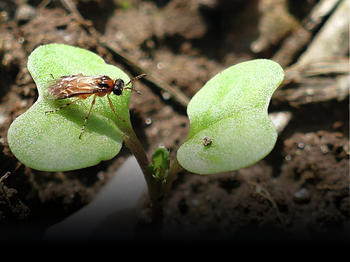Turnip sawfly
- Wasp 6-8 mm large, chest and abdomen yellow-orange colored. Head and sides of the chest black. Wings with black edge. Nymphs initially grey-green, later black-grey. Three pairs of sternum and eight pairs of anal feet. 2 to 3 generations.
- Only dangerous in mass occurrence, then growth and feeding damage increases very quickly. Window-, hole- or edge-eating. Later leaves are eaten down to the leaf veins (skeletal feeding).
CONTROL BENCHMARK
- Often, but not always, found in yellow traps. However, control for larval infestation must be carried out on the undersides of the leaves!
- Individual parts of the rapeseed fields may be affected earlier and more severely, depending on the direction of approach.
- Up to 4-leaf stage 10% leaf area damage, thereafter 1-2 caterpillars/plant.
- Insecticides against biting insects have sufficient effect. React quickly if there are many small caterpillars.
PREVENTION
- Partial reduction of pupae (up to 5 cm in the soil) through soil cultivation in the rape seed after harvest.
- Lower stand density usually means higher numbers of grubs / roots. Recommended minimum sowing rate 40-50 germinable grains/m².
- Predatory beetles decimate eggs and maggots.
- Nymph parasitisation by ichneumon flies and others.




